1993 BUICK CENTURY engine oil
[x] Cancel search: engine oilPage 203 of 324
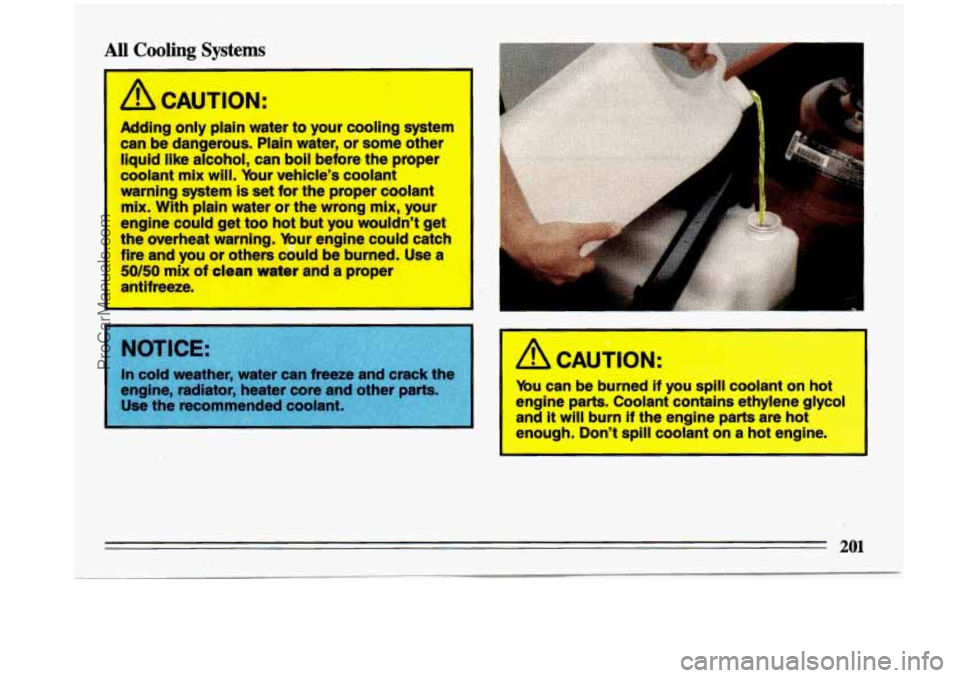
All Cooling Systems
A CAUTION:
Adding only plain water to your c.ooling system
can be dangerous. Plain water, or some other
liquid like alcohol, can boil before the proper
coolant mix will. Your vehicle's coolant
warning system is set for the proper coolant
mix.
With plain water or the wrong mix, your
engine could get too hot but you wouldn't get
the overheat warning.
Your engine could catch
fire and you or others could be burned. Use a
50/50 mix of clean water and a proper
antifreeze.
I
I
A CAUTION:
You can be burned if you spill coolant on hot
engine parts. Coolant contains ethylene
glycol
and it will burn if the engine parts are hot
enough. Don't spill coolant on
a hot engine. I
201
ProCarManuals.com
Page 223 of 324

.
n
Part 6 Service and Appearance Care
. .
Here you will find information about the care of your Buick . This part begins with service and fuel information.
and then
it shows how to check important fluid and lubricant levels . There is also technical information about
your vehicle. and a section devoted to
its appearance care .
Part 6 includes:
Service ........................................................................\
..... 222
Fuel ........................................................................\
...... 223
HoodRelease ....................................................................... \
226
Engine Oil ........................................................................\
. 227
Aircleaner ........................................................................\
2.3
TransaxleFluid ..................................................................... 236
Enginecoolant ..................................................................... 239
Power Steering Fluid ................................................................. 241
Windshield Washer Fluid .............................................................. 242
Brakes ........................................................................\
.... 243
Battery ........................................................................\
.... 244
BulbReplacement ................................................................... 245
Tires ........................................................................\
...... 251
Loadingyourvehicle ................................................................. 249
Appearancecare .................................................................... 258
Vehicle Identification Number (VIN), Add-on Electrical Equipment ............................ 265
Capacities and Specifications .......................................................... -270
Fuses&CircuitBreakers .............................................................. 266
ReplacementBulbs .................................................................... 269
ProCarManuals.com
Page 226 of 324
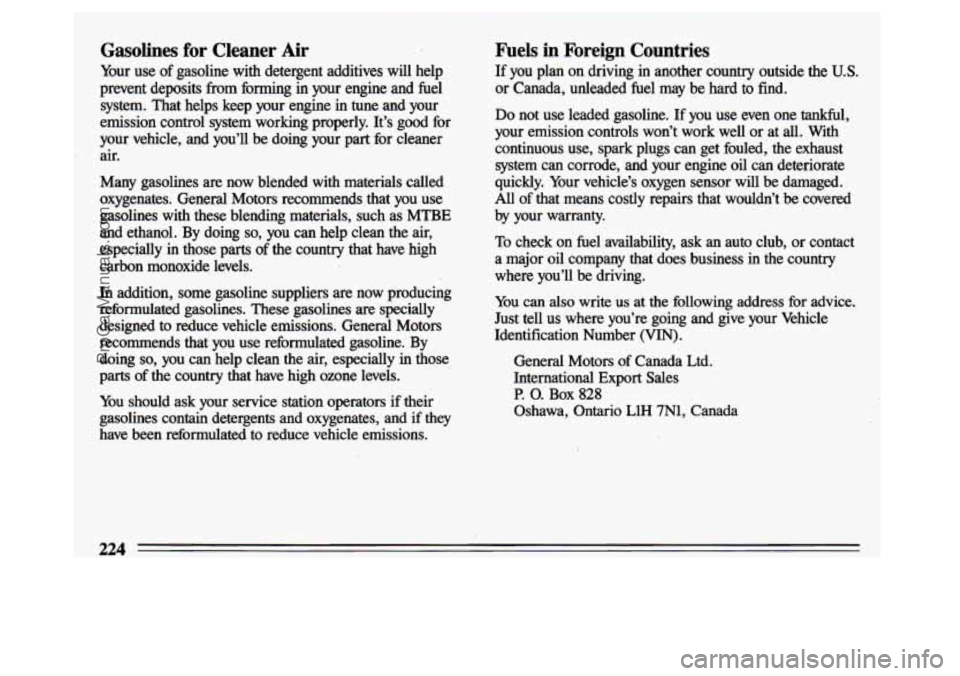
Gasolines for Cleaner Air
Your use of gasoline with detergent additives will help
prevent deposits
from forming in your engine and fuel
system. That helps keep your engine in tune and your
emission control system working properly. It’s good for
your vehicle, and you’ll be doing your part for cleaner
air.
Many gasolines
are now blended with materials called
oxygenates. General Motors recommends that you use gasolines
with these blending materials, such as MTBE
and ethanol.
By doing so, you can help clean the air,
especially
in those parts of the country that have high
carbon monoxide levels.
In addition, some gasoline suppliers are now producing
reformulated gasolines. These gasolines are specially
designed to reduce vehicle emissions. General Motors recommends that you use reformulated gasoline. By
doing
so, you can help clean the air, especially in those
parts of the country that have high ozone levels.
You should ask your service station operators if their
gasolines contain detergents and oxygenates, and if they
have been reformulated to reduce vehicle emissions.
F’uels in Foreign Countries
If you plan on driving in another country outside the U.S.
or Canada, unleaded fuel may be hard to find.
Do not use leaded gasoline. If you use even one tankful,
your emission controls won’t work well or at
all. With
continuous use, spark plugs can get fouled, the exhaust
system can corrode, and your engine oil can deteriorate
quickly. Your vehicle’s oxygen sensor will be damaged.
All of that
means costly repairs that wouldn’t be covered
by your warranty.
To check on fuel availability, ask an auto club, or contact
a major oil company that does business in the country
where
you’ll be driving.
You
can also write us at the following address for advice.
Just tell us where you’re going and give your Vehicle Identification Number
(VIN) .
General Motors of Canada Ltd.
International Export Sales
P. 0. Box 828
Oshawa, Ontario L1H 7N1, Canada
I
224
ProCarManuals.com
Page 229 of 324
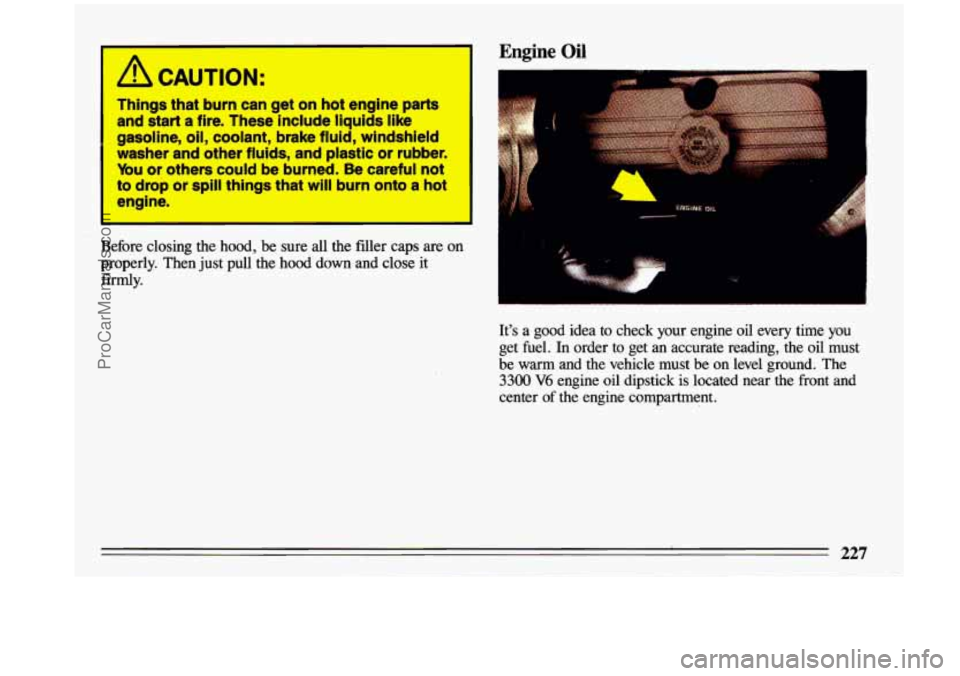
/i CAUTION:
Things that burn can get on hot engine parts
and start
a fire. These include liquids like
gasoline, oil, coolant, brake fluid, windshield
washer and other fluids, and plastic or rubber.
You or others could be burned. Be careful not
to drop
or spill things that will burn onto a hot
engine.
Before closing the hood, be sure all the filler caps are on
properly. Then just pull the hood down and close it
firmly.
Engine Oil
I‘
I
It’s a good idea to check your engine oil every time you
get fuel. In order to get an accurate reading, the oil must
be warm and the vehicle must be on level ground. The
3300 V6 engine oil dipstick is located near the front and
center
of the engine compartment.
ProCarManuals.com
Page 230 of 324
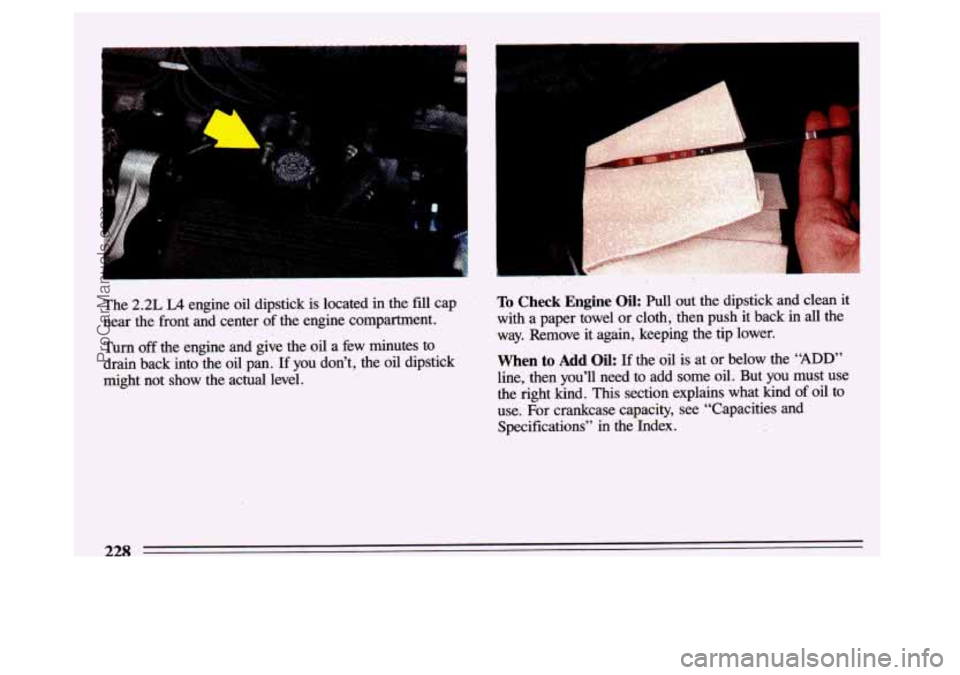
The 2.2L LA engine oil dipstick is located in the fill cap
near the front and center of the engine compartment.
Turn off the engine and give the oil a few minutes to
drain back into the oil pan.
If you don’t, the oil dipstick
might not show the actual level.
To Check Engine Oil: Pull out the dipstick and dean it
with a paper towel or cloth, then push it back in
all the
way. Remove it again, keeping the tip lower.
When to Add Oil: If the oil is at or below the “ADD”
line, then you’ll need to add some oil. But you must use
the right kind. This section explains what kind of
oil to
use. For crankcase capacity, see “Capacities and Specifications”
in the Index.
228 i
ProCarManuals.com
Page 232 of 324
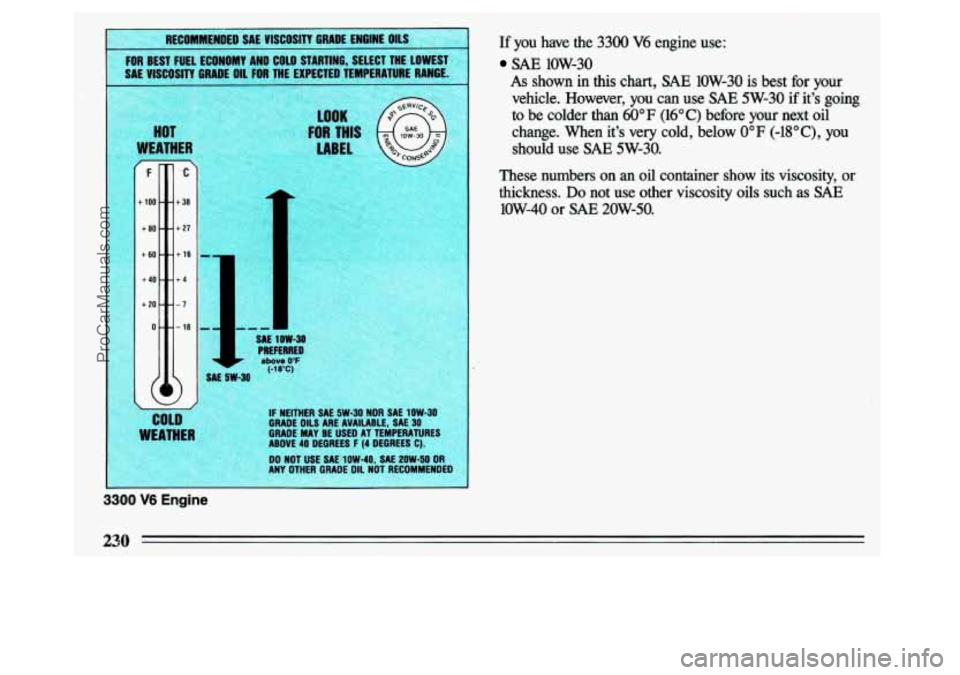
i
I ':
I 1
ISCOS E ENGINE OILS I '"'
FOR BEST FUEL ECONOMY AND COLD STARTING, SELECT THE LOWEST
I SAE VISCOSITY GRADE OIL FOR THE EXPECTED TEMPERATURE RANGE.
LOOK
LABEL
HOT FOR THIS WEATHER (
SAL 10W-3-
PREFERREl
AE 5W-30
COLD IF NEITHER SAE 5W-30 NOR SAE 1OW-30
GRADE OILS ARE AVAILABLE, SAE 30
ABOVE
40 DEGREES F (4 DEGREES C).
ANY OTHER GRADE OIL NOT RECOMMENDED WEATHER GRADE MAY BE USE0 AT TEMPERATURES
00 NOT USE SAE 1OW-40, SAE 2OW-50 OR
If you have the 3300 V6 engine use:
SAE 1OW-30
As shown in this chart, SAE 1OW-30 is best for your
vehicle. However, you can use
SAE 5W-30 if it's going
to
be colder than 60°F (16°C) before your next oil
change. When it's very cold, below 0°F (-18" C), you
should use
SAE 5W-30.
These numbers on an oil container show its viscosity, or
thickness.
Do not use other viscosity oils such as SAE
1OW-40 or SAE 20W-50.
ProCarManuals.com
Page 233 of 324
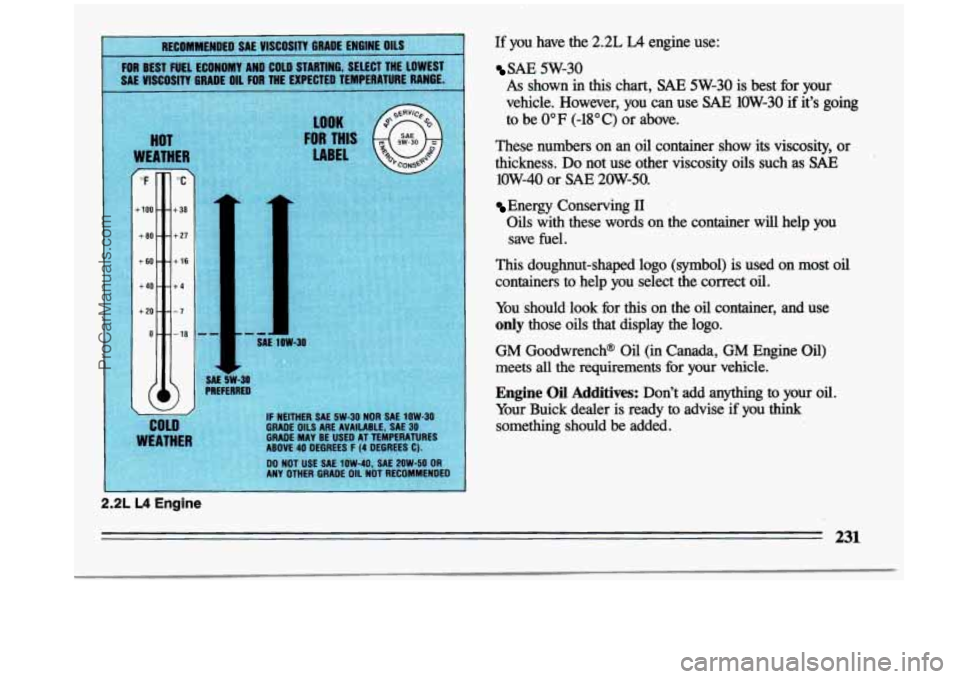
2.2L L4 Engine
LOOK
IR THI
LABEL
SAE 1OW-30
AE 5W-31 REFERREI
IF NEITHER SAE 5W-30 NOR SAE 1OW-30 GRADE OILS ARE AVAILABLE, SAE 30 GRADE MAY BE USE0 AT TEMPERATURES
ABOVE 40 DEGREES F (4 DEGREES C).
00 NOT USE SAE 1OW-40, SAE 2OW-50 Ofl ANY nTHFR CRAllF nll Nil1 RFfnMMFNnl
If you have the 2.2L LA engine use:
SAE 5W-30
As shown in this chart, SAE 5W-30 is best for your
vehicle. However, you can use
SAE 1OW-30 if it’s going
to be
0°F (-18°C) or above.
These numbers on
an oil container show its viscosity, or
thickness.
Do not use other viscosity oils such as SAE
low-40 or SAE 20W-50.
Energy Conserving II
Oils with these words on the container will help you save
fuel.
This doughnut-shaped logo (symbol) is used on most oil
containers to help you select the correct oil.
You should look for this on the oil container, and use
only those oils that display the logo.
GM Goodwrench@ Oil (in Canada, GM Engine Oil)
meets
all the requirements fix your vehicle.
Engine Oil Additives: Don’t add anything to your oil.
Your Buick dealer is ready to advise if you
think
something should be added.
231
ProCarManuals.com
Page 234 of 324

When to Change Engine Oil: See if any one of these is
true for you:
Most trips are less than 4 miles (6 km).
It’s below freezing outside and most trips are less than
10 miles (16 km).
The engine is at low speed most of the time (as in
door-to-door delivery,
or in stop-and-go traffic).
You tow a trailer often.
Most trips are through dusty places.
If any one of these is true for your vehicle, then you need
to change your oil and filter every 3,000 miles
(5 O00 km) or 3 months-whichever comes first.
If none
of them is true, change the oil every 7,500 miles
(12 500 km) or 12 months-whichever comes first.
Change the fdter at the first oil change and at every other
oil change afier that.
Engine Block Heater: An engine block heater can be a
big help if you have to park outside
in very cold weather,
0°F (-18°C) or colder. If your vehicle has this option, see
“Engine Block Heater”
in the Index.
What to Do with Used Oil:
-
/i CAUTION:
Used engine oil contains things that have
caused skin cancer in laboratory animals.
Don’t let used oil stay on your skin for very
long. Clean your skin and nails with soap and
water or a good hand cleaner. Wash or
properly throw away clothing or rags
containing used engine oil.
Used oil can be a real threat to the environment. If you
change your own oil, be sure to drain all free-flowing oil
from the filter before disposal. Don’t ever dispose of oil
by pouring it on the ground, into sewers, or into streams
or bodies of water. Instead, recycle it ‘by taking
it to a
place that collects used
oil. If you have a problem
properly disposing of your used oil, ask your dealer, a
service station or a local recycling center for help.
232
ProCarManuals.com